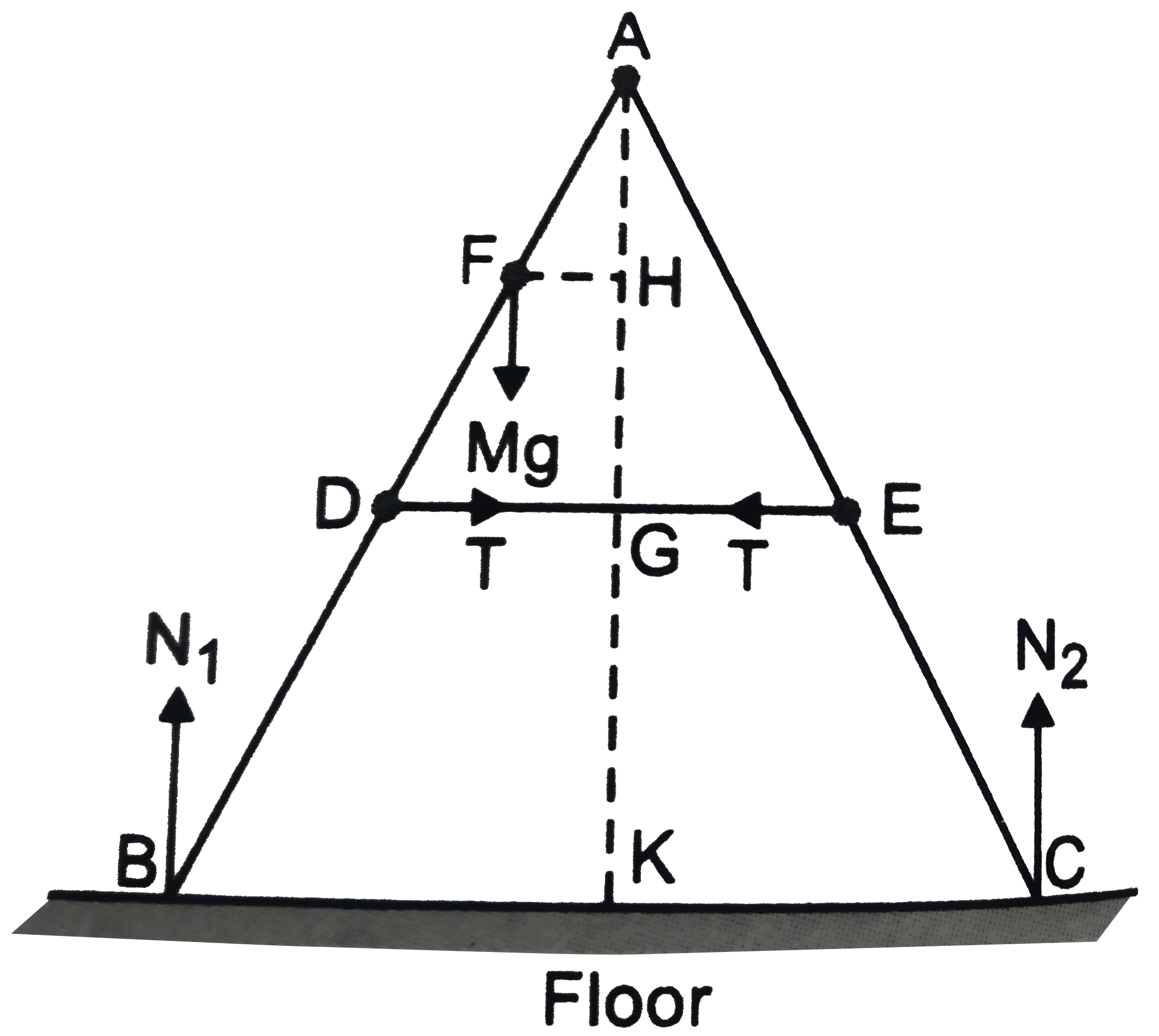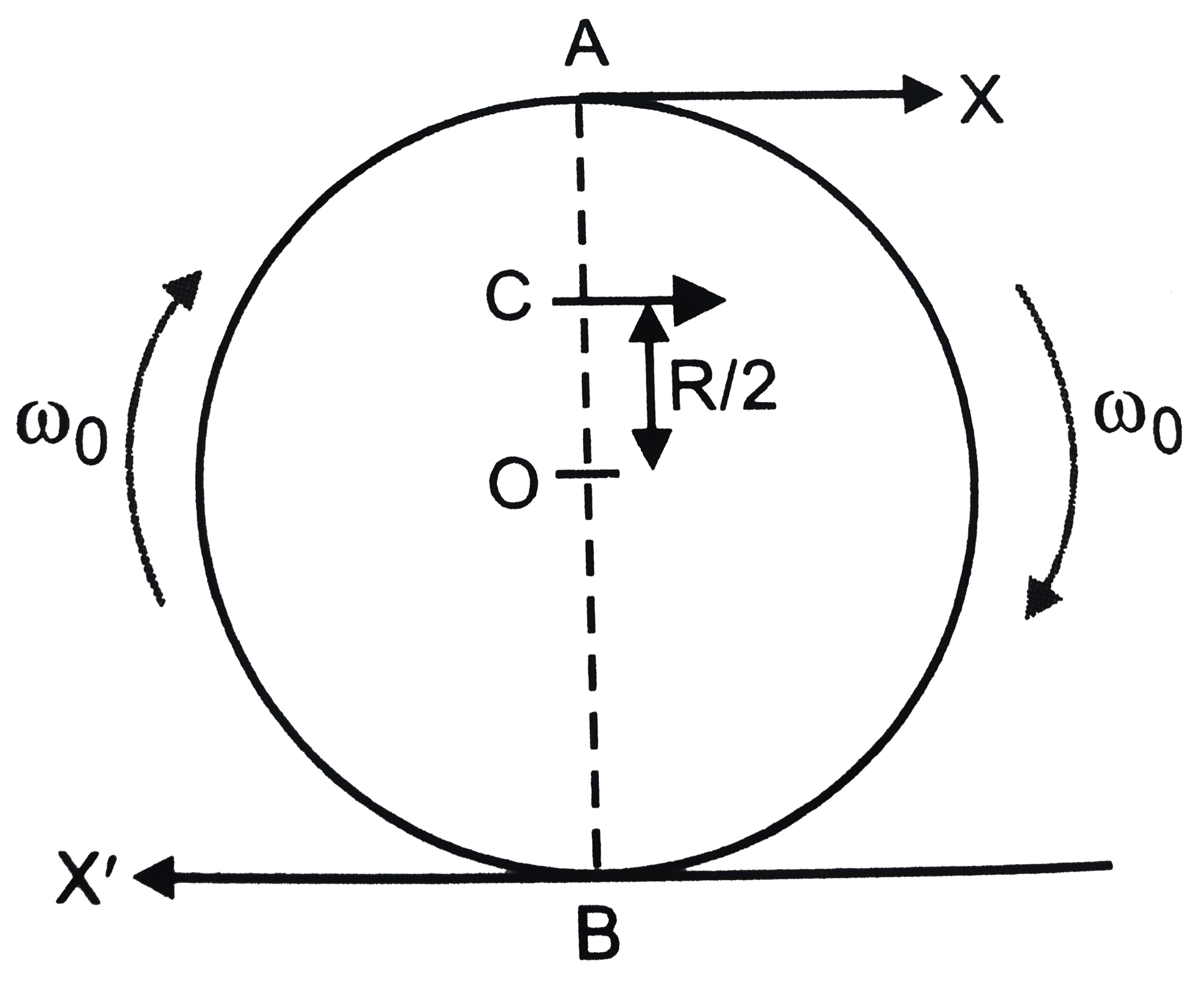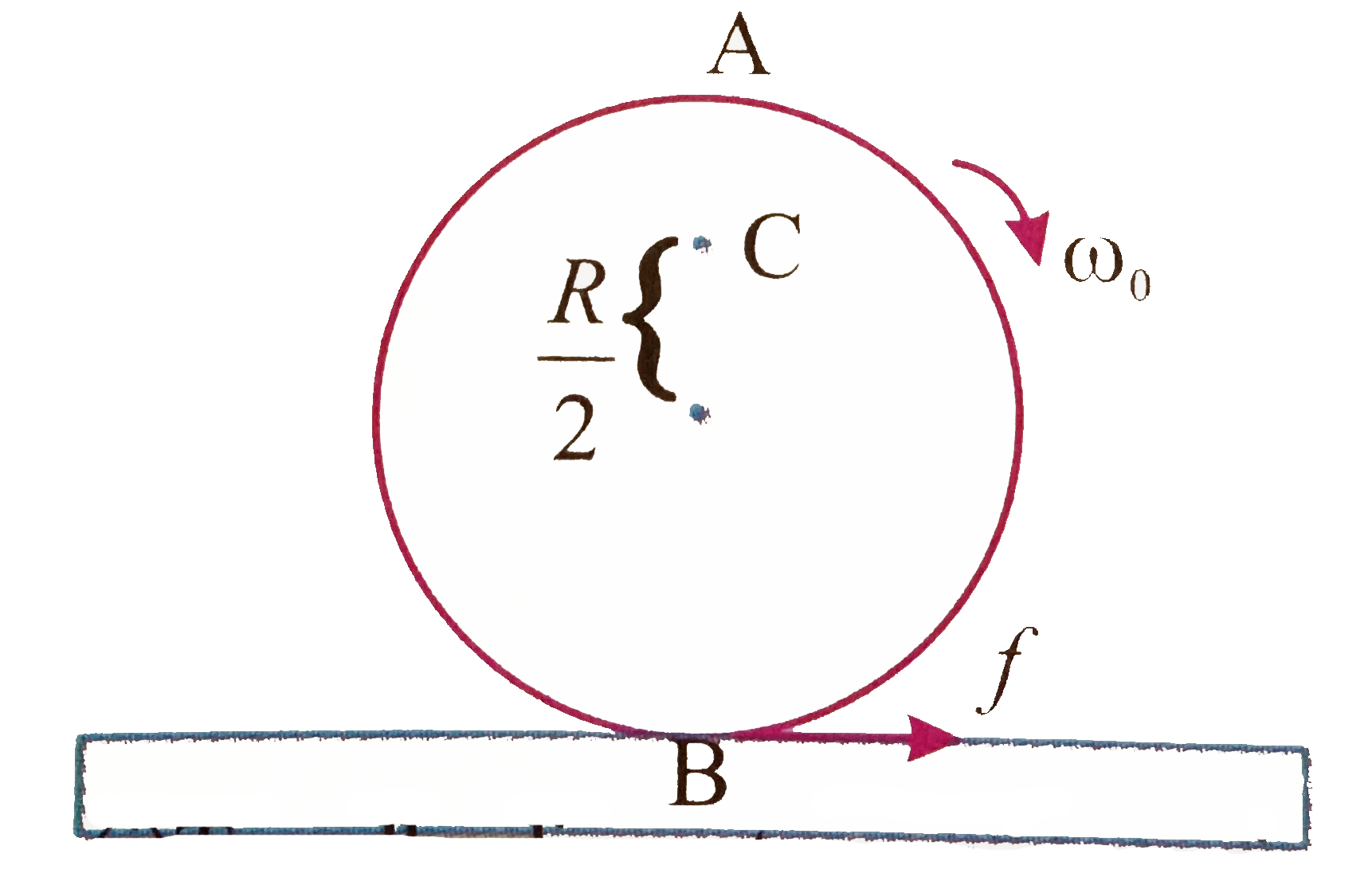Complete Solutions to NCERT FILE ( NCERT (ADDITIONAL EXERCISES) ) of chapter SYSTEMS OF PARTICLES AND ROTATIONAL MOTION of Class 11 book with complete answers and questions
| Class 11 | PHYSICS |
| Chapter | SYSTEMS OF PARTICLES AND ROTATIONAL MOTION |
| MODERN PUBLICATION | NCERT FILE ( NCERT (ADDITIONAL EXERCISES) ) |
| Number Of Questions | 12 |
| Academic Year | 2023-24 |
As shown in Fig. the two sides of a step ladder `BA` and `CA` are `1.6 m` long and hinged at `A`. A rope `DE, 0.5 m` is tied half way up. A weight `40 kg` is suspended from a point `F, 1.2 m` from B along the ladder` BA`. Assuming the floor to be fricionless and neglecting the weight of the ladder, find the tension in the rope and forces exerted by the floor on the ladder. (Take `g = 9.8 m//s^(2))`
(Hint. Consider the eqilibrium of each side of the ladder separately.)

View SolutionA man stands on a rotating platform, with his arms stretched horizontal holding a `5 kg` weight in each hand. The angular speed of the platform is `30` revolutions per minute. The man then brings his arms close to his body with the distance of each weight from the axis changing from `90 cm` to `20 cm`. moment of inertia of the man together with the platform may be taken to be constant and equal t `7.6 kg m^(2)`. (a) What is the his new angular speed ? (Neglect friction.)
(b) Is kinetic energy conserved in the process ? If not, from where does the change come about ?
View SolutionA bullet of mass `10 g` and speed `500 m//s` is fired into a door and gets embedded exactly at the centre of the door. The door is `1.0 m` wide and weight `12 kg`. It is hinged at one end and rotates about a vertical axis practically without friction. Find the angular speed of the door just after the bullet embeds into it.(Hint. The moment of inertia of the door about the vertical axis at one end is `ML^(2)//3)`
View SolutionTwo discs of moments of inertia `I_(1) and I_(2)` about their respective axes (normal to the disc and passing through the centre), and rotating with angular speed `omega_(1) and omega_(2)` are brought into contact face to face with their axes of rotation coincident . What is the angular speed of the two-disc system ?
View Solution(a) Prove the theorem of perpendicular axes.
(Hint : Square of the distance of a point (x, y) in the x-y plane from an axis through the origin and perpendicular to the plane is `(x^(2)+y^(2))`.
(b) Prove the theorem of parallel axes.
(Hint : If the centre of mass of a system of n particles is chosen to be the origin `summ_(i)r_(i)=0`).
View SolutionProve the result that the velocity `v` of translation of a rolling body (like a ring, disc, cylinder or sphere) at the bottom of an inclined plane of a height h is given by `v^(2) = (2gh)/((1 + k^(2)//R^(2))` using dynamical consideration (i.e. by consideration of forces and torque). Note k is the radius of gyration of the body about its symmetry axis, and `R` is the radius of the body. The body starts from rest at the top of the plane.
View SolutionA disc rotating about its axis with angular speed `omega_(0)` is placed lightly (without any translational pull) on a perfectly frictionless table. The radius of the disc is `R`. What are the linear velocities of the points `A, B and C` on the disc shown in Fig. Will the disc roll in the direction indicated ?

View Solution(i) Explain why friction is necessary to make the disc to roll in the direction indicated. (ii) Give the direction of frictional force at `B`, and the sense of frictional torque, before perfect rolling begins. (iii) What is the force of friction after perfect rolling begins?

View SolutionA solid disc and a ring, both of radius `10 cm` are placed on a horizontal table simultaneously, with initial angular speed equal to `10 pi rad//s`. Which of the two will start to roll earlier ? The coefficient of kinetic friction is `mu_(k) = 0.2`.
View SolutionA cylinder of mass `10 kg` and radius `15 cm` is rolling perfectly on a plane of inclination `30^(@)`. The coefficient of static friction is `mu_(s) = 0.25`.
(a) How much is the force of friction acting on the cylinder ?
(b) What is the work done against friction during rolling ?
(c ) If the inclination `theta` of plane is increased, at what value of `theta` does the cylinder begin to skid and not roll perfectly ?
View SolutionRead each statement below carefully and state with reasons, if it is true ot false. (a) During rolling the force of friction acts in the same direction as the direction of motion of c.m of the body. (b) The instantaneous speed of the point of contact during rolling is zero. (c ) The instantaneous acceleration of the point of contact during rolling is zero. (d) For perfect rolling motion, work done against friction is zero. (e) A wheel moving down a perfectly frictionless inclined plane will undergo slipping (not rolling motion).
View SolutionSeparation of motion of a system of particles into motion of the centre of mass and motion about the centre of mass:
(a)n Show `vecp= vecp_(i)+m_(i)vecV` where `vecp_(i)` is the momentum of the `i^(th)` particle (of mass `m_(i))` and `vecp_(i)=m_(i)vec v_(i)`, Not `vec v_(i)` is the velocity of the `i^(th)` particle relative to the centre ofmass.
Also, prove using the definition of the centre of mass `sum vec p_(i)=0`
(b) Show `K=K'+""_(1//2)MV^(2)` where K is the total kinetic energy of the system of particles, K is the total kinetic energy of the system when the particle velocities are taken with respect to the centre of mass and `MV^(2)//2` is the kinetic energy of the translation of the system as a whole (i.e. of the centre of mass motion of the system)
(c) Show `vecL= vecL+ vecR xxMV`
where `vecL'=sum vec r_(i) xx vec p_(i)` is the angular momentum of the system about the centre of mass with velocities taken relative to the centre of mass. Remember `vecr_(i)=vecr_(i)-vecR`, reat of the notation is the standard notation used in the chapter. Note `vecL' and M vecR xx vecV` can be said to be angular momenta, respectively, about and of the centre of mass of the system of particles.
(d) Show `(d vecL)/(dt)= sum vecr_(i)xx(d vecp')/(dt)` Further show that `(dvecL')/(dt)= vec tau_(ext)'` where Text is the sum of all external torques acting on the system about the centre of mass. (Hint: Use the definition of centre of mass and Newton's Third Law. Assume the internal forces between any two particles aet along the line joining the particles.)
View Solution
NCERT FILE ( NCERT (ADDITIONAL EXERCISES) ) questions and complete solutions for chapter SYSTEMS OF PARTICLES AND ROTATIONAL MOTION of MODERN PUBLISHERS PHYSICS (HINGLISH) of Class 11
All Exercises from MODERN PUBLICATION Class 11 PHYSICS SYSTEMS OF PARTICLES AND ROTATIONAL MOTION
- Chapter Practice Test (for Board Examination)
- COMPETITION FILE ( OBJECTIVE TYPE QUESTIONS (INTEGER TYPE QUESTIONS) )
- COMPETITION FILE ( OBJECTIVE TYPE QUESTIONS (JEE (Main) & Other State Boards for Engineering Entrance) )
- COMPETITION FILE ( OBJECTIVE TYPE QUESTIONS (MATCHING TYPE QUESTIONS) )
- COMPETITION FILE ( OBJECTIVE TYPE QUESTIONS MULTIPLE CHOICE QUESTIONS (with more than one correct answer) )
- COMPETITION FILE (OBJECTIVE TYPE QUESTIONS (ASSERTION REASON TYPE QUESTIONS) )
- COMPETITION FILE (OBJECTIVE TYPE QUESTIONS (MATRIX MATCH TYPE QUESTIONS) )
- COMPETITION FILE (OBJECTIVE TYPE QUESTIONS (MULTIPLE CHOICE QUESTIONS) (MULTIPLE CHOICE QUESTIONS WITH ONLY ONE CORRECT ANSWER) )
- Conceptual Questions
- HIGHER ORDER THINKING SKILLS & ADVANCED LEVEL QUESTIONS WITH ANSWERS
- NCERT FILE ( NCERT (ADDITIONAL EXERCISES) )
- NCERT FILE ( NCERT TEXTBOOK EXERCISES )
- NCERT FILE (NCERT EXEMPLAR PROBLEMS (OBJECTIVES QUESTIONS) (MULTIPLE CHOICE QUESTIONS (TYPE-I))
- NCERT FILE (NCERT EXEMPLAR PROBLEMS (SUBJECTIVES QUESTIONS) (Very Short Answer Type Questions))
- PRACTICE PROBLEMS
- PROBLEMS TOUGH & TRICKY
- REVISION EXERCISES (Additional Questions Carrying 1 mark )
- REVISION EXERCISES (Fill in the Blanks Carrying 1 mark )
- REVISION EXERCISES (Long Answer Questions Carrying 5 marks)
- REVISION EXERCISES (Numerical Problems)
- REVISION EXERCISES (Short Answer Questions Carrying 2 or 3 marks)
- REVISION EXERCISES (Very Short Answer Questions Carrying 1 mark)
- SOLVED EXAMPLES